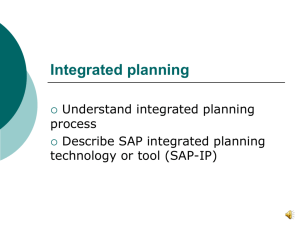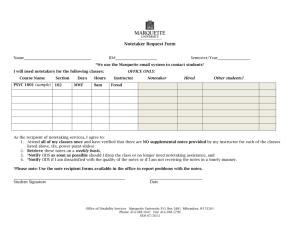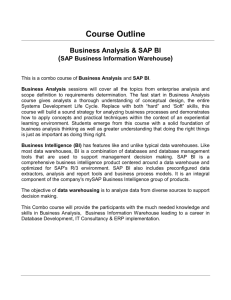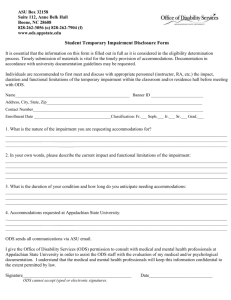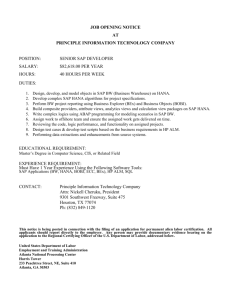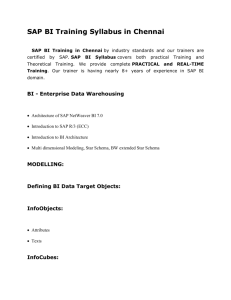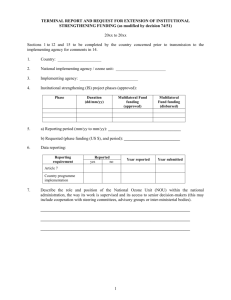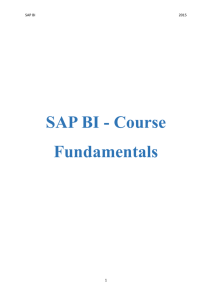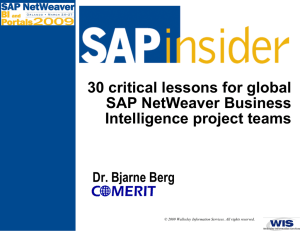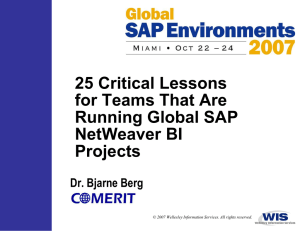Summary_05
advertisement
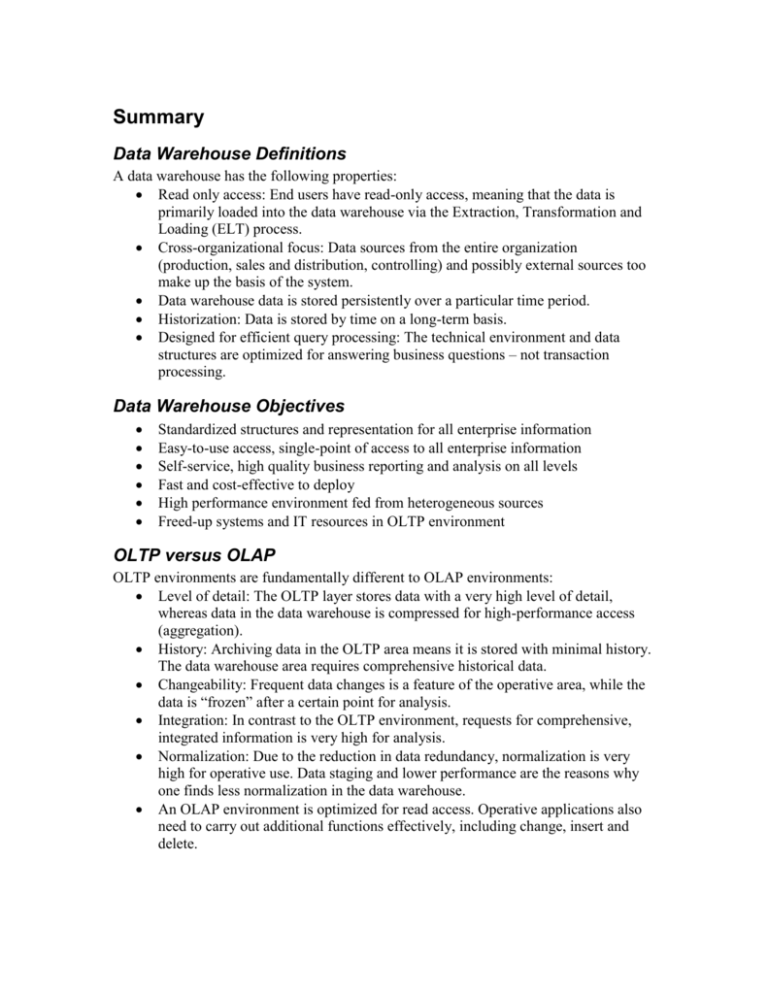
Summary Data Warehouse Definitions A data warehouse has the following properties: Read only access: End users have read-only access, meaning that the data is primarily loaded into the data warehouse via the Extraction, Transformation and Loading (ELT) process. Cross-organizational focus: Data sources from the entire organization (production, sales and distribution, controlling) and possibly external sources too make up the basis of the system. Data warehouse data is stored persistently over a particular time period. Historization: Data is stored by time on a long-term basis. Designed for efficient query processing: The technical environment and data structures are optimized for answering business questions – not transaction processing. Data Warehouse Objectives Standardized structures and representation for all enterprise information Easy-to-use access, single-point of access to all enterprise information Self-service, high quality business reporting and analysis on all levels Fast and cost-effective to deploy High performance environment fed from heterogeneous sources Freed-up systems and IT resources in OLTP environment OLTP versus OLAP OLTP environments are fundamentally different to OLAP environments: Level of detail: The OLTP layer stores data with a very high level of detail, whereas data in the data warehouse is compressed for high-performance access (aggregation). History: Archiving data in the OLTP area means it is stored with minimal history. The data warehouse area requires comprehensive historical data. Changeability: Frequent data changes is a feature of the operative area, while the data is “frozen” after a certain point for analysis. Integration: In contrast to the OLTP environment, requests for comprehensive, integrated information is very high for analysis. Normalization: Due to the reduction in data redundancy, normalization is very high for operative use. Data staging and lower performance are the reasons why one finds less normalization in the data warehouse. An OLAP environment is optimized for read access. Operative applications also need to carry out additional functions effectively, including change, insert and delete. SAP BW Architecture In principle, SAP BW architecture can be divided into three layers: The Administrator Workbench (transaction RSA1) is the central administration tool of a BW system. A BW system has only one productive client. Terminology and Objects in BW InfoCube Objects that can function both as data targets as well as InfoProviders. An InfoCube describes a self-contained dataset (from the reporting view), for example, for a business-oriented area. This dataset can be evaluated with a BEx query. An InfoCube is a quantity of relational tables that are created according to the SAP BW star schema: two large fact tables in the center, with several dimension tables surrounding it. SAP BW star schema The center of a multidimensional schema in BW are the two fact tables (E-fact table and F-fact table). The fact tables are surrounded by dimensions. In the fact tables the key figure values are stored. Dimension Table In BW the attributes of the dimension tables are called characteristics (e.g. material). The meta data object in BW that describes characteristics and also key figures (facts) is called InfoObject. There can be up to16 dimensions 3 dimensions exist with each InfoCube (whether they are used and thus visible or not) Time dimension Unit/ currency dimension Packet dimension The remaining 13 dimensions are for individual schema design Each dimension table may be up to 248 characteristics. Master Data Tables: AttributeTable Dependent attributes of a characteristic can be stored in a separate attribute table. Text Tables Textual descriptions of a characteristic are stored in a separate text table. External Hierarchy Tables Hierarchies of characteristics or attributes may be stored in separate hierarchy tables. InfoCube compression Compression finds records which are identical except for Request ID, then summarizes all these records. The summarized records are moved from the F to the E fact table An InfoCube compression is therefore important for query performance. It also helps manage Fact table size. Drawback: Requests can no longer be deleted from the InfoCube selectively. Operational Data Store The Operational Data Store (ODS) allows detailed data to be stored. Often line item detail is stored in the ODS and then summarized when updated into InfoCubes. It is possible to report against an ODS; however the ODS is not optimized for query performance like InfoCubes. InfoObject Business evaluation objects (for example, customers or sales) are called InfoObjects in BW. InfoObjects are subdivided into characteristics and key figures. InfoProvider An InfoProvider is an object using which queries can be defined and evaluated. InfoProviders are the objects or views relevant to reporting. For this reason it does not matter if these objects contain data or not. Examples for InfoProviders are: InfoCubes ODS Objects InfoObjects MultiProviders MultiProvider MultiProvider is a special InfoProvider that combines data from several InfoProviders, providing it for reporting. The MultiProvider itself does not contain any data. Its data comes exclusively from the InfoProviders on which it is based. A MultiProvider can be made up of various combinations of the following InfoProviders: InfoCubes ODS object InfoObject MultiProviders are required if a query has to access more than one InfoCube or ODS objects. The InfoCube and ODs objects are combined in one MultiProvider, which the query then can access. Queries A query is a collection of a selection of characteristics and key figures (InfoObjects) for the analysis of the data of an InfoProvider. A query always refers exactly to one InfoProvider, whereas you can define as many queries as you like for each InfoProvider. Therefore you have to create a MultiProvider if you want to access the data of several InfoCubes or ODS objects in one query.^ Process chains Sequence of processes that are scheduled in the background to wait for a particular event. Some of these processes trigger an additional event, which in turn can start other processes. Process chains can be used for data loading. Transfer Rules Transfer rules transfer data from the DataSource into the InfoSource and transform or modify the data where necessary. Transfer rules are specific to the DataSource Update Rules The update rules specify how the data (key figures, time characteristics, characteristics) is updated from the communication structure in an InfoSource into a data target. Update rules are specific to the data target Extractor Program used to fill the extraction structure of a DataSource with data from datasets in the SAP source system. DataTarget Data load-relevant view of a BW object with a physical data store. DataTargets are e.g.: InfoCubes ODS objects InfoObjects Reporting To satisfy the different user requirements different front-ends for displaying the queries are available. Always available are the Business Explorer Analyzer (BEx Analyzer, i.e. an Excel Plug-in) and Web Reporting, i.e. displaying the query results in a web browser. But there are also third party tools like Crystal Reports. Query Designer The BEx query designer is a tool for defining queries that are based on a selection of characteristics and key figures (InfoObjects) or on reusable InfoProvider structures. You can use the queries that you define in the BEx Query Designer in all front-ends. Information Broadcasting Information Broadcasting allows the distribution of BW information ... via different channels ... E-Mail (works independently from an EP installation) Enterprise Portal ... in different formats ... HTML, MHTML BEx Analyzer Workbooks ZIP Files … of different sources … BI Web Applications - Dashboards, cockpits BEx Analyzer Workbooks Queries … in different modes… Online pre-calculated Business Content Business Content contains SAP delivered objects that enable you to structure your reporting quickly, from data extraction from SAP source systems, to roles that supply employees in a company with information they need to complete their work. These information models include: Roles Queries and workbooks (BW reports, and particular views of them) InfoProviders that the reports are based on InfoObjects that provide the characteristics and key figure Update rules and extractors for SAP R/3, mySAP.com business applications, and other selected applications Data loading DataSource and InfoSource Business Information Warehouse Server Staging Engine InfoCubes Update Rules Communication Communication structure structure Transfer Rules (Replicated) Transfer Rules Transfer Transfer Structure Structure Transfer Transfer Structure Structure InfoSource Transfer Rules Transfer Transfer Structure Structure DataSource Transfer Transfer Structure Structure Extract Extract Source Source Structure Structure Transfer Transfer Structure Structure Extract Extract Source Source Structure Structure OLTP System 1 SAP AG 2003, Title of Presentation, Speaker Name / 2 Transfer Transfer Structure Structure Extract Extract Source Source Structure Structure OLTP System 2 Possible types of Source systems: Other SAP systems (e.g. R/3) Universal Data Connector 3rd party systems (via BAPI) flatfiles (ASCII and CSV) SOAP DBconnect Aggregates ... are like InfoCubes, ... are always based on InfoCubes ... summarize ("aggregate") data of the originating InfoCube, ... contain redundant information, but ... accelerate the access to that information, BW BPS Since BW Release 3.5, the Planning functionality from SEM (SEM-BPS Business Planning and Simulation) is included in BW, named BW-BPS. There are several functions available for performing the planning: Predefined planning functions (such as copy, revaluation, distribution,…) Fox-formulas Exits Manual planning
